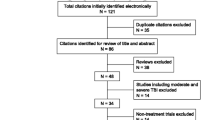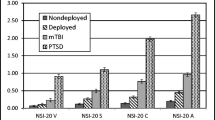Abstract
To evaluate the outcomes of the antiarousal medications valproate, risperidone, and quetiapine on completion of treatment of cognitive processing therapy (CPT) for PTSD. A case series of fifty treatment-seeking adult (≥18 years) veterans with mild traumatic brain injury and combat-related PTSD who had unsuccessful trials of 2 or more first-line agents and previously declined treatment with trauma-focused therapy, seen at the psychiatric outpatient services of the local Polytrauma Rehabilitation Center from January 1, 2014, through December 31, 2017. Patients were prescribed valproate (n = 8), risperidone (n = 17), or quetiapine (n = 25) and were referred for individual weekly treatment with CPT. Outcome measurements of interest were measures of engagement and completion rate of CPT, PTSD Checklist total score (range, 0–80; higher scores indicate greater PTSD severity) and arousal subscale score (range, 0–24; higher scores indicate greater arousal severity), and clinical observations of sleep variables. Of the 50 patients included in the study, 48 (96%) were men; mean (SD) age was 36 (8) years. Eighteen (86%) patients initially receiving quetiapine and none taking valproate or risperidone became adequately engaged in and completed CPT. Among patients who completed CPT, the mean decrease in the PTSD Checklist score was 25 [95% CI, 30 to 20] and 9 (50%) patients no longer met criteria for PTSD. These preliminary findings support quetiapine as an adjunctive medication to facilitate CPT. A pragmatic trial is needed to evaluate the efficacy, safety, and feasibility of quetiapine to improve engagement in and completion rate of CPT.


Similar content being viewed by others
References
Swanson TM, Isaacson BM, Cyborski CM, French LM, Tsao JW, Pasquina PF. Traumatic brain injury incidence, clinical overview, and policies in the US military health system since 2000. Public Health Rep. 2017;132(2):251–9.
Cohen BE, et al. Mental health diagnoses and utilization of VA non-mental health medical services among returning Iraq and Afghanistan veterans. J Gen Intern Med. 2010;25(1):18–24.
Tsan JY, et al. Primary care-mental health integration and treatment retention among Iraq and Afghanistan war veterans. Psychol Serv. 2012;9(4):336–48.
Diagnostic and statistical manual of mental disorders , fifth edition: American Psychiatric Association; 2013.
Cabana MD, et al. Why don't physicians follow clinical practice guidelines? A framework for improvement. Jama. 1999;282(15):1458–65.
Duff J, Walker K, Omari A. Translating venous thromboembolism (VTE) prevention evidence into practice: a multidisciplinary evidence implementation project. Worldviews Evid-Based Nurs. 2011;8(1):30–9.
Hoge CW, et al. Mild traumatic brain injury in U.S. soldiers returning from Iraq. N Engl J Med. 2008;358(5):453–63.
Chew E, Zafonte RD. Pharmacological management of neurobehavioral disorders following traumatic brain injury--a state-of-the-art review. J Rehabil Res Dev. 2009;46(6):851–79.
Krystal JH, et al. It is time to address the crisis in the pharmacotherapy of posttraumatic stress disorder: a consensus statement of the PTSD psychopharmacology working group. Biol Psychiatry. 2017.
Asnis GM, et al. SSRIs versus non-SSRIs in post-traumatic stress disorder: an update with recommendations. Drugs. 2004;64(4):383–404.
Treatment of Posttraumatic Stress Disorder in Military and Veteran Populations: Final Assessment. 2014, Committee on Treatment of Posttraumatic Stress Disorder. Institute of Medicine.: Washington, DC.
Collett GA, et al. Prevalence of central nervous system polypharmacy and associations with overdose and suicide-related behaviors in Iraq and Afghanistan war veterans in VA care 2010-2011. Drugs Real World Outcomes. 2016;3(1):45–52.
Kennedy JE, et al. Posttraumatic stress symptoms in OIF/OEF service members with blast-related and non-blast-related mild TBI. NeuroRehabilitation. 2010;26(3):223–31.
Foa EB. Prolonged exposure therapy: past, present, and future. Depress Anxiety. 2011;28(12):1043–7.
Goodson JT, et al. Outcomes of prolonged exposure therapy for veterans with posttraumatic stress disorder. J Trauma Stress. 2013;26(4):419–25.
Powers MB, et al. A meta-analytic review of prolonged exposure for posttraumatic stress disorder. Clin Psychol Rev. 2010;30(6):635–41.
Jeffreys MD, et al. Evaluating treatment of posttraumatic stress disorder with cognitive processing therapy and prolonged exposure therapy in a VHA specialty clinic. J Anxiety Disord. 2014;28(1):108–14.
Kilpatrick D.G., B CL , Behavior Therapy Some cautionary remarks on treating sexual assault victims with implosion . Vol. 15. 1984. 4.
Pitman RK, et al. Psychiatric complications during flooding therapy for posttraumatic stress disorder. J Clin Psychiatry. 1991;52(1):17–20.
Pitman RK, et al. Emotional processing during eye movement desensitization and reprocessing therapy of Vietnam veterans with chronic posttraumatic stress disorder. Compr Psychiatry. 1996;37(6):419–29.
Tarrier N, et al. A randomized trial of cognitive therapy and imaginal exposure in the treatment of chronic posttraumatic stress disorder. J Consult Clin Psychol. 1999;67(1):13–8.
Imel ZE, et al. Meta-analysis of dropout in treatments for posttraumatic stress disorder. J Consult Clin Psychol. 2013;81(3):394–404.
Steenkamp MM, et al. Psychotherapy for military-related PTSD: a review of randomized clinical trials. Jama. 2015;314(5):489–500.
Hembree EA, et al. Do patients drop out prematurely from exposure therapy for PTSD? J Trauma Stress. 2003;16(6):555–62.
Becker CB, Zayfert C, Anderson E. A survey of psychologists' attitudes towards and utilization of exposure therapy for PTSD. Behav Res Ther. 2004;42(3):277–92.
Hing M, et al. Special operations forces and incidence of post-traumatic stress disorder symptoms. J Spec Oper Med. 2012;12(3):23–35.
Jaeger JA, et al. Factors associated with choice of exposure therapy for PTSD. Int J Behav Consult Ther. 2009;5(3–4):294–310.
Matsumoto Y, et al. Vorinostat ameliorates impaired fear extinction possibly via the hippocampal NMDA-CaMKII pathway in an animal model of posttraumatic stress disorder. Psychopharmacology. 2013;229(1):51–62.
Acheson D, et al. The effect of intranasal oxytocin treatment on conditioned fear extinction and recall in a healthy human sample. Psychopharmacology. 2013;229(1):199–208.
Popiel A, et al. Prolonged exposure, paroxetine and the combination in the treatment of PTSD following a motor vehicle accident. A randomized clinical trial - the "TRAKT" study. J Behav Ther Exp Psychiatry. 2015;48:17–26.
Schneier FR, et al. Combined prolonged exposure therapy and paroxetine for PTSD related to the world trade center attack: a randomized controlled trial. Am J Psychiatry. 2012;169(1):80–8.
Simon NM, et al. Paroxetine CR augmentation for posttraumatic stress disorder refractory to prolonged exposure therapy. J Clin Psychiatry. 2008;69(3):400–5.
Echiverri-Cohen A, et al. Changes in temporal attention inhibition following prolonged exposure and sertraline in the treatment of PTSD. J Consult Clin Psychol. 2016;84(5):415–26.
Jun JJ, Zoellner LA, Feeny NC. Sudden gains in prolonged exposure and sertraline for chronic PTSD. Depress Anxiety. 2013;30(7):607–13.
Jerud AB, et al. The effects of prolonged exposure and sertraline on emotion regulation in individuals with posttraumatic stress disorder. Behav Res Ther. 2016;77:62–7.
Flanagan JC, et al. Augmenting prolonged exposure therapy for PTSD with intranasal oxytocin: a randomized, placebo-controlled pilot trial. J Psychiatr Res. 2017;98:64–9.
Rauch SA, et al. Imagery vividness and perceived anxious arousal in prolonged exposure treatment for PTSD. J Trauma Stress. 2004;17(6):461–5.
Deacon B, et al. Maximizing the efficacy of interoceptive exposure by optimizing inhibitory learning: a randomized controlled trial. Behav Res Ther. 2013;51(9):588–96.
Lund BC, et al. Declining benzodiazepine use in veterans with posttraumatic stress disorder. J Clin Psychiatry. 2012;73(3):292–6.
Viola J, et al. Pharmacological management of post-traumatic stress disorder: clinical summary of a five-year retrospective study, 1990-1995. Mil Med. 1997;162(9):616–9.
Rothbaum BO, et al. A randomized, double-blind evaluation of D-cycloserine or alprazolam combined with virtual reality exposure therapy for posttraumatic stress disorder in Iraq and Afghanistan war veterans. Am J Psychiatry. 2014;171(6):640–8.
Krystal JH, et al. Adjunctive risperidone treatment for antidepressant-resistant symptoms of chronic military service-related PTSD: a randomized trial. Jama. 2011;306(5):493–502.
Davis LL, et al. Divalproex in the treatment of posttraumatic stress disorder: a randomized, double-blind, placebo-controlled trial in a veteran population. J Clin Psychopharmacol. 2008;28(1):84–8.
Villarreal G, et al. Efficacy of quetiapine monotherapy in posttraumatic stress disorder: a randomized, placebo-controlled trial. Am J Psychiatry. 2016;173(12):1205–12.
Patricia A, Resick PD, Candice M. Monson, Ph.D., Kathleen M. chard, Ph.D., Cognitive Processing Therapy: Veterans/Military Version: Therapist's manual. Washington, DC: Department of Veterans's Affairs; 2014.
Ghodke-Puranik Y, et al. Valproic acid pathway: pharmacokinetics and pharmacodynamics. Pharmacogenet Genomics. 2013;23(4):236–41.
Dold M, et al. Antipsychotic augmentation of serotonin reuptake inhibitors in treatment-resistant obsessive-compulsive disorder: a meta-analysis of double-blind, randomized, placebo-controlled trials. Int J Neuropsychopharmacol. 2013;16(3):557–74.
Leucht S, et al. Comparative efficacy and tolerability of 15 antipsychotic drugs in schizophrenia: a multiple-treatments meta-analysis. Lancet. 2013;382(9896):951–62.
Borison RL, Arvanitis LA, Miller BG. ICI 204,636, an atypical antipsychotic: efficacy and safety in a multicenter, placebo-controlled trial in patients with schizophrenia. US SEROQUEL Study Group. J Clin Psychopharmacol. 1996;16(2):158–69.
Sachs G, et al. Quetiapine with lithium or divalproex for the treatment of bipolar mania: a randomized, double-blind, placebo-controlled study. Bipolar Disord. 2004;6(3):213–23.
El-Khalili N, et al. Extended-release quetiapine fumarate (quetiapine XR) as adjunctive therapy in major depressive disorder (MDD) in patients with an inadequate response to ongoing antidepressant treatment: a multicentre, randomized, double-blind, placebo-controlled study. Int J Neuropsychopharmacol. 2010;13(7):917–32.
Weathers, F.W., Litz, B. T., Keane, T. M., Palmieri, P. A., Marx, B. P., & Schnurr, P. P. National Center for PTSD, The PTSD Checklist for DSM-5 (PCL-5) – [Measurement instrument]. 2013.
Murphy D, et al. Exploring optimum cut-off scores to screen for probable posttraumatic stress disorder within a sample of UK treatment-seeking veterans. Eur J Psychotraumatol. 2017;8(1):1398001.
Galovski TE, et al. Augmenting cognitive processing therapy to improve sleep impairment in PTSD: a randomized controlled trial. J Consult Clin Psychol. 2016;84(2):167–77.
Horacek J, et al. Mechanism of action of atypical antipsychotic drugs and the neurobiology of schizophrenia. CNS Drugs. 2006;20(5):389–409.
Robert S, et al. Quetiapine improves sleep disturbances in combat veterans with PTSD: sleep data from a prospective, open-label study. J Clin Psychopharmacol. 2005;25(4):387–8.
Wiegand MH, et al. Quetiapine in primary insomnia: a pilot study. Psychopharmacology. 2008;196(2):337–8.
Author information
Authors and Affiliations
Corresponding author
Ethics declarations
Conflict of Interest
The authors report no conflicts of interest.
Ethical Approval
All procedures performed in studies involving human participants were in accordance with the ethical standards of the institutional and/or national research committee and with the 1964 Helsinki declaration and its later amendments or comparable ethical standards.
Informed Consent
Informed consent was not required for this retrospective chart review study.
Additional information
Publisher’s Note
Springer Nature remains neutral with regard to jurisdictional claims in published maps and institutional affiliations.
Rights and permissions
About this article
Cite this article
Baig, M.R., Wilson, J.L., Lemmer, J.A. et al. Enhancing Completion of Cognitive Processing Therapy for Posttraumatic Stress Disorder with Quetiapine in Veterans with Mild Traumatic Brain Injury: a Case Series. Psychiatr Q 90, 431–445 (2019). https://doi.org/10.1007/s11126-019-09638-z
Published:
Issue Date:
DOI: https://doi.org/10.1007/s11126-019-09638-z




